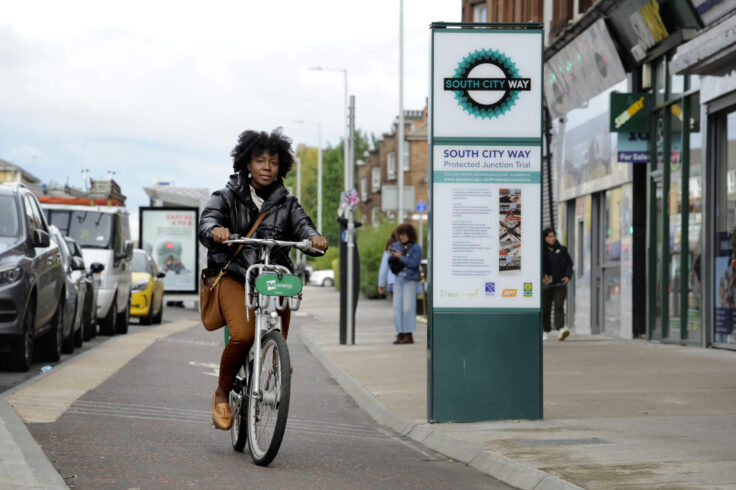November 22, 2024
How These Three Cities Are Scaling and Improving Urban Cycling
In 2021, ITDP launched the Cycling Cities campaign during COP26 to provide governments, planners, and advocates with tools and resources that promote cycling as a safe, sustainable, and affordable transport option.
Register for the “Mastering the Cycling City” course today in our Learning Hub.
Since its inception, the campaign has focused on developing and scaling best practices from cities around the world that are leading the way in infrastructure and policy, particularly in the Global South. Initially targeting a cohort of 25 cities, the campaign now includes 34 cities and nearly 50 partner organizations. It has also succeeded in facilitating 40+ events and publishing numerous research products on the economic, social, and climate benefits of increasing urban cycling. In 2024, the cohort cities delivered hundreds of kilometers of cycle lanes, as well as hosted programs and trainings to get more people on bicycles. This includes:
-
Over 210 kilometers of protected cycling lanes and 420 kilometers of unprotected lanes, totaling 630+ kilometers of new infrastructure on the ground
-
Over 320 bicycle training and learn-to-ride activities
-
Over 1,000 car-free and open streets events
Watch the recording of the webinar and its translations here.
Cohort cities are also planning an additional 773 kilometers of cycle lanes for delivery in 2025, the campaign’s final year. To mark the campaign’s third anniversary, ITDP hosted a webinar highlighting various successes from three diverse cohort cities — Glasgow, UK; Niterói, Brazil; and Pimpri-Chinchwad, India. Representatives from these cities shared their progress in advancing cycling initiatives.
The session was moderated by Fernanda Rivera, a sustainable mobility policy expert previously working for Mexico City’s Ministry of Mobility. Fernanda brought an important perspective to the conversation, underscoring the need to capitalize on political will when cities have it, and lay the groundwork for long-term change through policy and institutions.
Glasgow: Developing a Connected Network of Cycle Lanes
Jan Boyd, Project Officer at the Glasgow City Council, highlighted the city’s progress implementing “City Ways,” Glasgow’s active travel corridors that serve as a backbone for the city’s cycle lane network. The 2.6 km South City Way was completed this year, toward the ambitious 270 km City Network of protected routes under development. These initiatives aim to improve cycling accessibility, enhance pedestrian spaces, and create a cohesive citywide network. Glasgow is also prioritizing cycling connections from neighborhoods to the city center and building or retrofitting bridges that support trips by bicycle. Learn more about Glasgow’s work here.

Niterói: Launching Bikeshare to Expand Access to Cycling
João Pedro Boechat, Director of Cycling Infrastructure for the City of Niterói, presented on the city’s recently launched and already successful NitBike bikeshare program. The program design was informed by ITDP’s planning guidelines and is funded by the city. Since its launch, NitBike facilitates 6,200 daily bikeshare trips with more than six trips per bike per day. The program has helped reduce over 144 tons of CO₂ emissions. Boechat noted the program’s particular popularity among young residents, especially university students, who benefit from its affordability and convenience. Learn more about the bikeshare program here.

Pimpri-Chinchwad: Funding Cycling and Walking Transformations
Rutuja Nivate, an Urban Designer with ITDP India, detailed the City of Pimpri Chinchwad’s ambitious goals for walking and cycling. The city’s transport policy targets having 90% of trips completed via cycling, walking, or public transport by 2036. The Harit Setu NMT Master Plan and the Urban Streetscapes Program aim to better connect neighborhoods and enhance cycling infrastructure in Pimpri Chinchwad, the third fastest growing city in India.
Remarkably, over 55% of the city’s transport budget is allocated to sustainable transport, with one-third dedicated to NMT in 2024–25. The city is also looking to diverse sources of funding to support project implementation. To meet its $41.9 million annual funding requirement, Pimpri Chinchwad is seeking external funding through international competitions, grants, and partnerships with development banks. Learn more about the city’s transformation here.

Navigating Challenges and Building Support
Panelists discussed inter-related challenges in implementing cycling initiatives. In Glasgow, misinformation spread via social media prompted government staff to host information sessions that provided a forum for clarification. Niterói adopted a gradual approach to installing NitBike stations to address resistance from affluent neighborhoods concerned about systems encroaching on sidewalks. Pimpri Chinchwad, recognizing municipal funding limitations, actively pursued additional sources of funding for cycling and walking project implementation.
Ultimately, all of the speakers emphasized the importance of engaging with and leveraging feedback from citizens, community groups, and neighborhood officials to build broad-based support for more sustainable transport initiatives. Initiatives like the Cycling Cities campaign provided all three cities with valuable resources and peer-to-peer learning opportunities to make their pro-cycling advocacy efforts a success.
Continue following updates from ITDP’s Cycling Cities as the campaign enters its final year.
